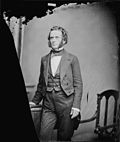List of representatives
1817–1855: one seat, then two, then four, then none, then one
| Cong ress | Years | Seat A | Seat B | Seat C | Seat D | ||||||||||||
|---|---|---|---|---|---|---|---|---|---|---|---|---|---|---|---|---|---|
| Representative | Party | Electoral history | Representative | Party | Electoral history | Representative | Party | Electoral history | Representative | Party | Electoral history | ||||||
| 15th | December 10, 1817 | District created | |||||||||||||||
| December 10, 1817 – March 3, 1819 |  George Poindexter (Woodville) | Democratic-Republican | Elected in 1817. Retired. | No 2nd seat | No 3rd seat | No 4th seat | |||||||||||
| 16th | March 4, 1819 – March 3, 1821 | Christopher Rankin (Natchez) | Democratic-Republican [a] | Elected in 1819. Re-elected in 1820. Re-elected in 1822. Re-elected in 1824. Died. | |||||||||||||
| 17th | March 4, 1821 – March 3, 1823 | ||||||||||||||||
| 18th | March 4, 1823 – March 3, 1825 | ||||||||||||||||
| 19th | March 4, 1825 – March 14, 1826 | Jacksonian | |||||||||||||||
| March 14, 1826 – July 10, 1826 | Vacant | ||||||||||||||||
| July 10, 1826 – March 3, 1827 | William Haile (Woodville) | Jacksonian | Elected July 11, 1826 to finish Rankin's term and seated December 4, 1826. Re-elected later in 1826. Resigned. | ||||||||||||||
| 20th | March 4, 1827 – July 10, 1828 | ||||||||||||||||
| July 10, 1828 – October 21, 1828 | Vacant | ||||||||||||||||
| October 21, 1828 – March 3, 1829 |  Thomas Hinds (Greenville) | Jacksonian | Elected October 20, 1828 to finish Haile's term and seated December 8, 1828. Elected August 4–5, 1828 to the next term. Retired. | ||||||||||||||
| 21st | March 3, 1829 – March 3, 1831 | ||||||||||||||||
| 22nd | March 4, 1831 – March 3, 1833 | Franklin E. Plummer (Westville) | Jacksonian | Elected in 1830. Re-elected in 1832. Retired to run for U.S. senator. | |||||||||||||
| 23rd | March 4, 1833 – March 3, 1835 | Harry Cage (Woodville) | Jacksonian | Elected in 1832. Retired. | |||||||||||||
| 24th | March 4, 1835 – July 31, 1836 |  John F. H. Claiborne (Madisonville) | Jacksonian | Elected in 1835. Re-elected in 1837 but election was invalidated. | David Dickson (Jackson) | Anti-Jacksonian | Elected in 1835. Died. | ||||||||||
| July 31, 1836 – January 7, 1837 | Vacant | ||||||||||||||||
| January 7, 1837 – March 3, 1837 |  Samuel J. Gholson (Athens) | Jacksonian | Elected November 7, 1836 to finish Dickson's term and seated January 7, 1837. [1] Re-elected in 1837 but election was invalidated. | ||||||||||||||
| 25th | March 4, 1837 – July 17, 1837 | Vacant | Vacant | ||||||||||||||
| July 18, 1837 – February 5, 1838 |  John F. H. Claiborne (Madisonville) | Democratic | Credentials presented but election successfully contest and seat declared vacant. |  Samuel J. Gholson (Athens) | Democratic | Credentials presented but election successfully contest and seat declared vacant. | |||||||||||
| February 5, 1838 – May 29, 1838 | Vacant | Vacant | |||||||||||||||
| May 29, 1838 – March 3, 1839 |  Seargent S. Prentiss (Vicksburg) | Whig | Elected to finish Claiborne's term. Retired. |  Thomas J. Word Thomas J. Word (Pontotoc) | Whig | Elected to finish Gholson's term. Retired. | |||||||||||
| 26th | March 4, 1839 – March 3, 1841 |  Jacob Thompson (Oxford) | Democratic | Elected in 1839. Re-elected in 1841. Re-elected in 1843. Re-elected in 1845. Redistricted to the 1st district . |  Albert G. Brown (Gallatin) | Democratic | Elected in 1839. Retired. | ||||||||||
| 27th | March 4, 1841 – March 3, 1843 |  William M. Gwin (Vicksburg) | Democratic | Elected in 1841. Renominated but declined. | |||||||||||||
| 28th | March 4, 1843 – March 3, 1845 | William H. Hammett (Princeton) | Democratic | Elected in 1843. Retired. | Robert W. Roberts (Hillsboro) | Democratic | Elected in 1843. Re-elected in 1845. Redistricted to the 3rd district and lost re-election. |  Tilghman Tucker (Columbus) | Democratic | Elected in 1843. Retired. | |||||||
| 29th | March 4, 1845 – June 1846 |  Stephen Adams (Aberdeen) | Democratic | Elected in 1845. Retired. |  Jefferson Davis (Warrenton) | Democratic | Elected in 1845. Resigned to command regiment in Mexican–American War. | ||||||||||
| June 1846 – January 26, 1847 | Vacant | ||||||||||||||||
| January 26, 1847 – March 3, 1847 | Henry T. Ellett (Port Gibson) | Democratic | Elected to finish Davis's term. Retired. | ||||||||||||||
| 29th | March 4, 1847 – March 3, 1849 | No at-large seats. Starting with the 1847 election, Mississippi elected all its representatives in districts until 1853. | |||||||||||||||
| 31st | March 4, 1849 – March 3, 1851 | ||||||||||||||||
| 32nd | March 4, 1851 – March 3, 1853 | ||||||||||||||||
| 33rd | March 4, 1853 – March 3, 1855 |  William Barksdale (Columbus) | Democratic | Elected in 1853. Redistricted to the 3rd district . | In 1852, one representative was elected at-large, the remainder from districts. | ||||||||||||